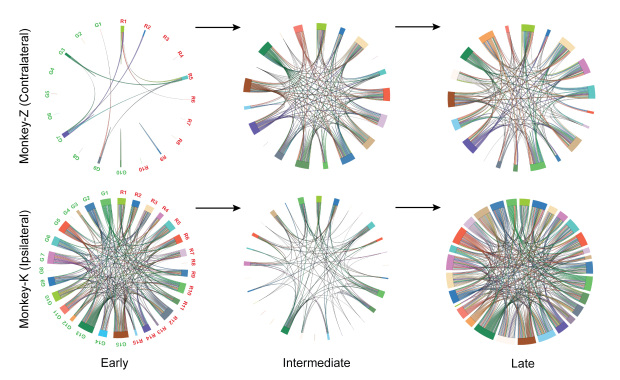Karthikeyan Balasubramanian, senior researcher in the Hatsopoulos lab, is the first author on a new paper in Nature that shows that amputees can control a robotic arm using only their thoughts. Professor Nicho Hatsopoulos (Organismal Biology and Anatomy) is the corresponding author. Hatsopoulos lab research associate Kazutaka Takahashi and alumna Mukta Vaidya (Computational Neuroscience '16) also contributed.
Using juice as a training tool, researchers were able to study three amputee rhesus monkeys' brain activity as they learned to manipulate a robotic arm using their minds. (The monkeys' limbs were amputated ten, six, and four years ago after sustaining injuries in order to save the monkeys' lives; they were not amputated for this study.) The researchers measured the neural activity in their brains as they learned. The two who had electrodes implanted on the contralateral (opposite) side of the brain from the amputated limb (i.e., the side that would have controlled that limb) developed dense neural networks from sparse ones. The monkey whose electrode was implanted on the ipsilateral (same) side of the brain as the amputated limb began with dense neural networks that thinned out and then increased again as learning happened (see figure below).

Comparison of network density between the contralateral and ipsilateral monkeys. When using the brain machine interface, the contralateral monkey showed a steady increase in the network connectivity. On the contrary, the ipsilateral monkey showed an initial pruning before having a steady increase in the network density. Each node in the diagram corresponds to a neuron (R – reach and G – grasp neurons).
The researchers plan to combine this work with other groups' research to equip neuroprosthetic limbs with sensory feedback.
Read the full story on Science Life.
The study, “Changes in Cortical Network Connectivity with Long-term Brain-Machine Interface Exposure after Chronic Amputation,” was published on November 27, 2017. Additional authors include Joshua Southerland and Andrew H. Fagg from the University of Oklahoma; Islam Badreldin and Karim Oweiss from the University of Florida; Ahmed Eleryan from Michigan State University; Kai Qian from the Illinois Institute of Technology; and Marc W. Slutzky from Northwestern University.